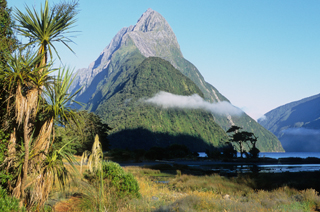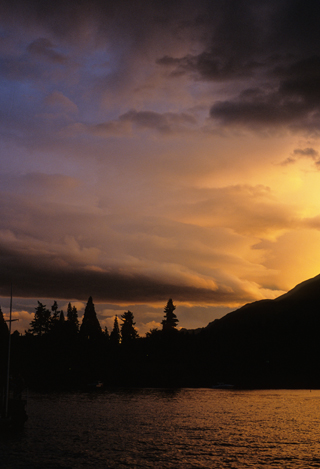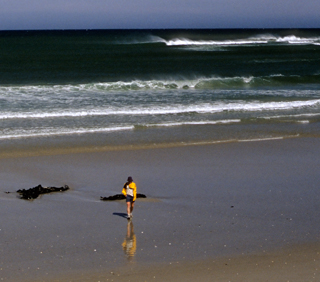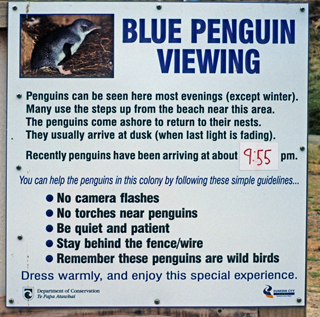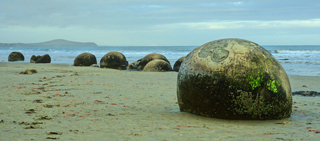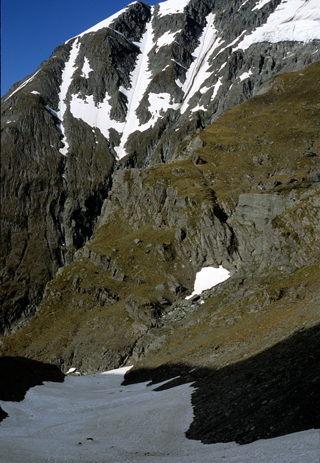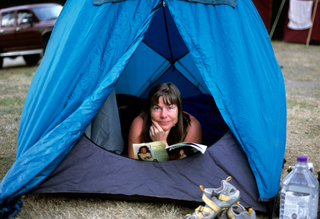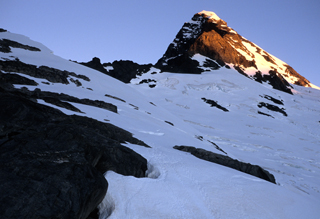
Mt. Aspiring and the NW Ridge at sunset.
 Colin Todd hut and early morning fog. Colin Todd hut and early morning fog.
 Climbing towards Bevan Col in the early morning fog. Climbing towards Bevan Col in the early morning fog.
 Descent from Bevan Col. Fog has given way to bright sunshine. Descent from Bevan Col. Fog has given way to bright sunshine.
 Below the waterfull crux and above the head of Matukituki River Valley. The climbing is over but there remains a very long downhill walk from here. Below the waterfull crux and above the head of Matukituki River Valley. The climbing is over but there remains a very long downhill walk from here.
 The first of many "swing bridges." This one has a capacity of one person at a time. The first of many "swing bridges." This one has a capacity of one person at a time.
|
It was an epic day! We left the hut at 6:30 a.m. and travelled across
the Bonar Glacier. The snow was firm and the footing was good. At Bevan
Col, we put on crampons for the descent on the snowfields. It was cool,
windy, and foggy. And the foggy conditions resulted in some very
interesting photographs of the group moving across the snow. Eventually
we ran out of snow and travelled on rock carefully finding our way down
the cairned track.
Then we hit the crux at the waterfall and gorge. We scouted the area
extensively and eliminated all possible routes but one. That must be the
way. Roping up, we single belayed Tom across the roaring stream, then
double belayed Susan and Rene, followed by a single belay for David.
Carefully traversing and downclimbing the rock slabs, we found the
rappel anchors. With only a short rope, we had to do a single-rope
rappel/abseil. Two pitches later and we were out of the gorge—which
we nicknamed "Bevanschlucht." And that was the easy part!
The rest of the day we travelled on faint to good to excellent tracks,
crossed numerous swing bridges, traversed ancient beech forests, ducked
under an ice cave, crossed uncountable small streams, and walked
endlessly. Finally we arrived at the car park. More than fifteen hours
after leaving Colin Todd hut we were done. It was 10 p.m. and twilight
was rapidly fading.
Although we could have stayed at the Aspiring Hut (a Department of
Conservation, DOC, hut)—about a two hour walk upvalley from the
car park—we had chosen to keep moving. Because we were so tired
and sore, we had decided to drive out of the park and to stay in Wanaka
so we could attend to our overworked bodies. Additionally, the weather
was changing and rain would start overnight. At least part of the road
from the car park to the main road forded streams and we were concerned
that rain would result in these fords being too deep to cross with our
sedan.
On the previous day, two climbers (Mark and Karl) had hiked up the Bevan
Col route in one day to the Colin Todd hut. Their plan was to climb Mt.
Aspiring the next day and then walk out the same day. We know that they
were successful because they PASSED US on the way out! These two
fellows were incredibly strong and fast. Most impressive.
(I found some videos on YouTube that document another groups' adventures
on Mt. Aspiring. Their
Day 1 ,
Day2, and
Day3 are very similar to ours.)
|























 Colin Todd hut and early morning fog.
Colin Todd hut and early morning fog. Climbing towards Bevan Col in the early morning fog.
Climbing towards Bevan Col in the early morning fog. Descent from Bevan Col. Fog has given way to bright sunshine.
Descent from Bevan Col. Fog has given way to bright sunshine. Below the waterfull crux and above the head of Matukituki River Valley. The climbing is over but there remains a very long downhill walk from here.
Below the waterfull crux and above the head of Matukituki River Valley. The climbing is over but there remains a very long downhill walk from here. The first of many "swing bridges." This one has a capacity of one person at a time.
The first of many "swing bridges." This one has a capacity of one person at a time.









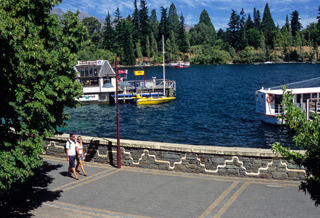 View of the waterfront in Queenstown from our hotel room.
View of the waterfront in Queenstown from our hotel room. Sunset over Lake Wakatipu in Queenstown.
Sunset over Lake Wakatipu in Queenstown. This is the bus that will transport us to Te Anau and the Milford Track.
This is the bus that will transport us to Te Anau and the Milford Track.






















